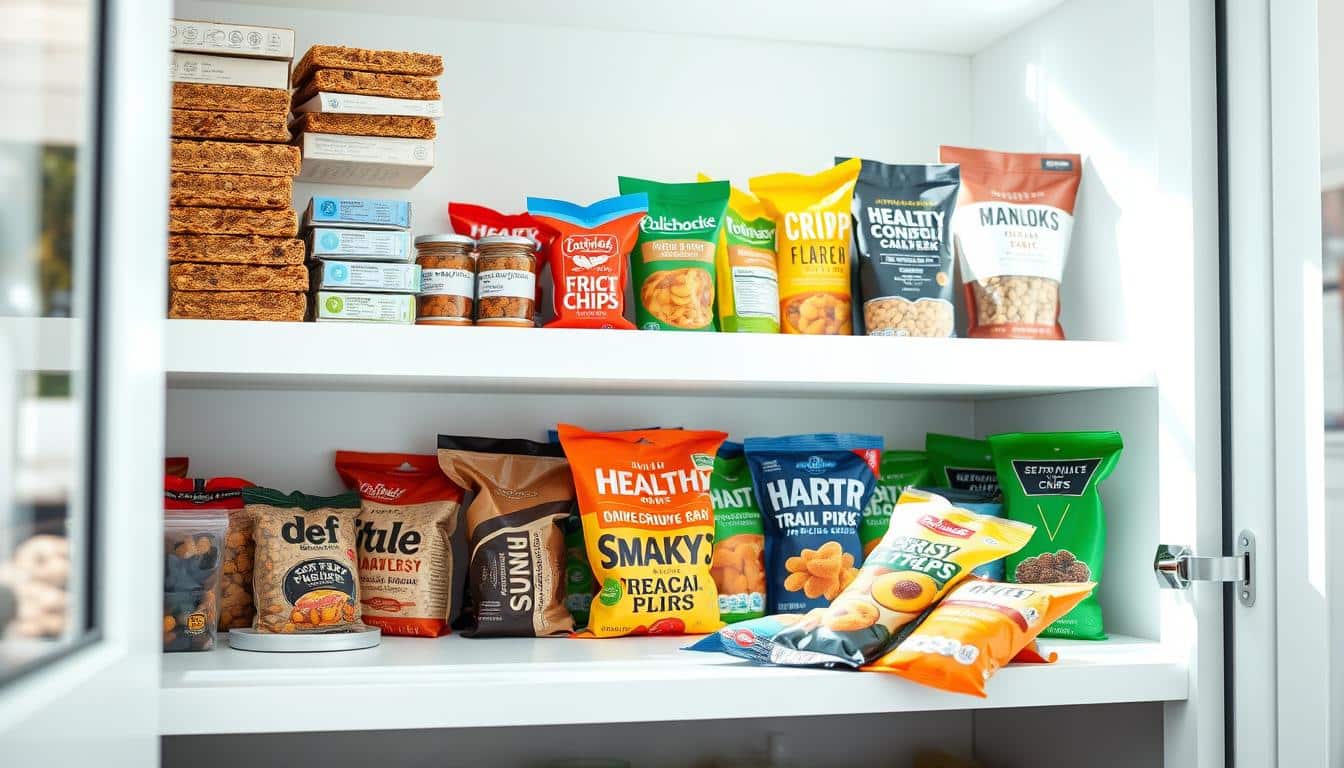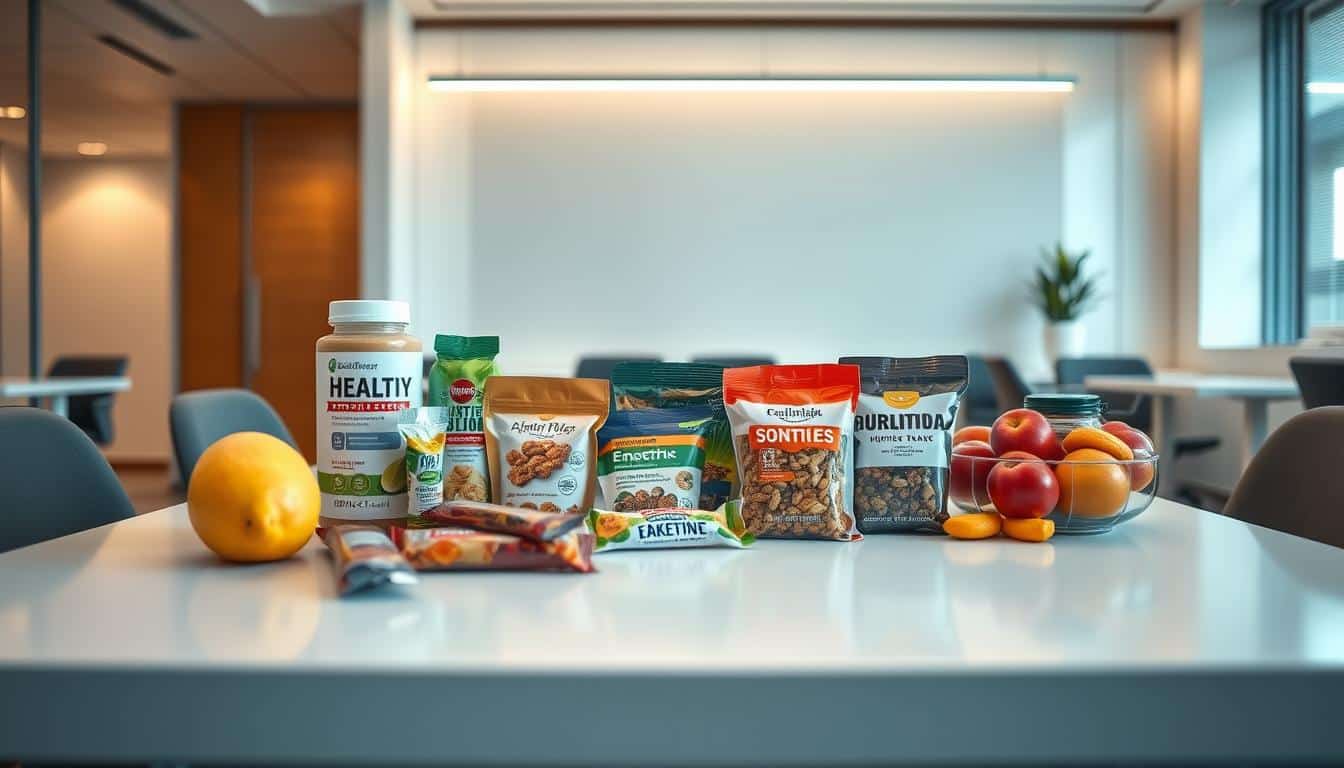In today’s fast-paced work environment, eating healthy is key for productivity and well-being. It’s especially important for office workers who often use elevators. Elevator-accessible healthy eating tips can help. By adopting effective healthy eating strategies at work, employees can lower health risks linked to sitting too much.
Workplace wellness programs that offer good food choices boost health and energize workers. Simple changes in what we eat can have big benefits for health and how well we work.
Understanding the Importance of Healthy Eating in the Workplace
Healthy eating at work is super important. It helps improve health and boosts how well employees feel and work. Eating right can make people feel better and lower health risks.
Having good food choices at work can even make people more productive and happy. With more people becoming overweight, promoting health at work is key.
Studies show that eating well helps employees do better. Wellness programs with good diets and exercise make healthier employees. When people feel good, they work better and create a happier place to work.
Employers who focus on health can also save on healthcare costs. It’s good for both the employees and the company.
Elevator-Accessible Healthy Eating Tips for Office Workers
It’s key to make healthy food choices easy for office workers. Especially in buildings where elevators are common. Making nutritious foods accessible helps employees choose them more often. This approach is good for both diet and creating a healthy workplace.
Promoting Convenience and Health
Having healthy foods available at work promotes wellness. When fresh fruits, nuts, and snacks full of nutrients are easy to grab, employees eat better. This makes it easier to avoid junk food and helps maintain a healthy diet.
Impact on Employee Well-Being
Easy access to nutritious foods improves employee well-being. Eating foods full of vitamins and whole foods boosts mood, energy, and focus. Workplaces should offer healthy options to help with both physical and mental health. Encouraging physical activity, like taking the stairs, adds to the benefits.
Utilizing Wholesome Food Options for Meetings
Choosing the right foods for workplace meetings can boost participation and health. Serving healthy foods at gatherings sets a good tone, inspiring better eating habits. Aiming for half the options to be fruits and veggies adds color and important nutrients.
Encouraging Fruits and Vegetables
It’s key to have a variety of fruits and vegetables for meeting snacks. Think about these ideas:
- Serve colorful fruit platters with seasonal selections.
- Include veggie trays with dips like hummus or yogurt for extra taste.
- Make simple salads with various textures and flavors.
These choices make it more likely for employees to pick healthier snacks. They’ll feel satisfied and full of energy.
Importance of Whole-Grain Foods
Along with fruits and veggies, offering whole-grain foods is crucial. They help people feel full and maintain energy during the meeting. See these strategies:
- Choose whole-grain breads for sandwiches or wraps.
- Offer brown rice or quinoa salads as sides.
- Go for whole-grain crackers or popcorn instead of usual snacks.
Adding whole-grain foods means you’re making the meeting healthier. This helps everyone stay focused and productive. Mixing wholesome fruits, veggies, and whole grains makes meetings better for all.
Meal Portion Control for Better Health
Understanding how to control meal sizes is key to eating healthier. When employees manage their portion sizes, they stay healthier. Companies can help by stressing the need for the right serving sizes.
One good way is to serve smaller amounts of proteins, like meat and cheese, and refined carbs. This helps workers figure out the right portions and pushes them to choose foods that are good for them. By doing this, it’s easier to manage how many calories they eat, leading to a healthier way of living.
It’s helpful when employees make half their plate fruits and veggies. This adds more fiber and vitamins and helps control portions. With these steps, businesses can support a lifestyle that’s both healthy for their workers and good for overall well-being.
Keeping Snacks Nutritious and Low-Calorie
In today’s fast office life, having healthy snacks is key to staying energized and well. People often grab quick snacks, so it’s important to have low-calorie, nutritious options. Offering a range of healthy snacks helps improve eating habits and cuts down on high-calorie junk food.
Nutrient-Dense Snack Choices
Nutritious snacks can boost productivity at work. Some top picks are:
- Raw vegetables like carrots, cucumbers, and bell peppers
- Whole grain crackers or rice cakes
- Nuts such as almonds or walnuts in moderation
- Fresh fruits including apples, bananas, and berries
These choices are packed with vitamins and minerals. They help maintain high energy and focus all day.
Minimizing Sugary Treats
Cutting back on sugary snacks in the office is crucial. It’s better to limit items like pastries and candy. Teaching employees about the benefits of picking healthy snacks over sugary ones supports better choices. By providing low-calorie options, employees won’t face the energy slumps sugar often causes.
Implementing Healthy Condiment Options at Work
Adding healthy condiments at work can really change how we eat. Most traditional sauces are full of calories, sugar, and salt. This isn’t good for our health. By picking healthier options, employees can improve their meals and eat smarter.
Try offering mustard, salsa, or low-fat dressings for a start. These choices are tasty but don’t harm our health. They help us eat better and stay balanced, especially at work.
To help everyone eat right, give out small servings of these condiments. This helps control how much we eat, letting us enjoy food without overdoing it. Having these healthier choices encourages us to eat well. It makes our workplace much healthier.
Promoting Hydration with Healthy Beverages
Keeping hydrated at work boosts employee productivity and focus. Having healthy drink options available makes a wellness culture. Water should be the main drink, along with low-calorie choices, to foster a place where good hydration habits grow.
Encouraging Water and Low-Calorie Drinks
To promote hydration at work, it’s key to have water and healthy drinks easy to grab. Adding unsweetened herbal teas and sparkling water gives tasty options without sugar. This can reduce the consumption of sugary drinks with high calories.
- Install water coolers and encourage regular refills.
- Offer flavored seltzer water to increase interest in low-calorie beverages.
- Provide herbal teas during breaks for a refreshing yet healthy drink choice.
Creating a Supportive Office Environment for Healthy Choices
A supportive office helps people eat better and feel well. Adding physical activity to the day boosts work output and happiness. Offices encouraging exercise lets employees do short, healthy activities.
Physical Activity Integration into the Workday
Adding exercise breaks during work hours works well. Staff can do stretches, take small walks, or play sports together. These approaches help:
- Organizing group walks during breaks
- Offering standing or treadmill desks
- Scheduling weekly physical activity challenges
This not only helps with fitness but also with working as a team.
Utilizing Stairs Instead of Elevators
Choosing stairs over elevators is an easy health boost. It increases daily exercise and is good for the heart. This choice shows the office’s health dedication and sparks friendly chats among staff.

Signs pointing to the stairs remind everyone to pick the healthier path.
The Role of Team Support in Healthy Eating Initiatives
Creating a health-focused culture at work really depends on teamwork. When everyone shares their journey to eat better, it creates a strong sense of togetherness and responsibility. This environment encourages everyone to make healthier choices with the support of their team.
Encouraging Group Participation
Team activities and challenges are great for eating healthy together. Consider trying out these ideas:
- Organize group cooking classes focusing on healthy recipes.
- Establish healthy eating competitions to motivate participation.
- Create teams to share meal plans and tips for maintaining healthier diets.
Gathering Employee Feedback
Getting feedback is key for better health programs. It’s important for organizations to really listen to their employees. They can do this by:
- Regular surveys to assess employee satisfaction with health initiatives.
- Focus groups to discuss challenges encountered in maintaining healthy habits.
- Anonymous suggestion boxes for honest input regarding health programs.
Setting Up a Workplace Wellness Program
Creating a good workplace wellness program needs careful planning and action. It’s important to set clear goals about employee health. Companies should aim to build a culture that cares about health. This will lead to better morale and work productivity.
Key parts of a corporate wellness program include:
- Defined goals that align with company values and employee needs
- Policies that encourage healthy eating at work
- Events that motivate employees to join in and stay active
- Incentives for making healthier lifestyle choices
Talking effectively within the company can boost participation. Sharing the gains of a wellness program shows its positive effects on staff well-being. It results in a more dedicated team that values their health and their colleagues’ health.
Using Educational Resources to Promote Healthy Eating
Bringing educational tools for healthy eating into work places boosts wellness programs. A smart plan uses online nutrition guides and fun workshops at the office. These help workers learn about better food choices. This improves their health and work performance.
Web-Based Nutritional Programs
Online nutrition education is convenient and easy to use. Workers can learn in their free time. This helps them really understand the lessons.
These online tools include:
- Interactive meal planning tools
- Informative articles and videos on healthy eating
- Access to personalized dietary assessments
These features help employees grasp nutrition basics and apply them daily.
Workshops and Informational Sessions
Workshops at the office are great for learning by doing. Topics might range from how to prep meals to understanding different foods. The content can be customized for each team. Workshops offer:
- Hands-on learning experiences
- Creating a sense of community around healthy eating
- Encouraging open discussions about food choices
Sessions like these build a workplace focused on health. They inspire everyone to choose healthier foods.
Conclusion
Making smart food choices at work can really boost employee happiness and their work. If companies offer easy access to healthy foods, they’re showing they care about their team’s health. Offering good snacks, water, and nutritious meals can make a big difference in how everyone feels at work.
It’s key to make these healthy habits a normal part of our day. Doing this not only helps us but makes the whole workplace better. When we all eat better, we create a lively and effective team.



